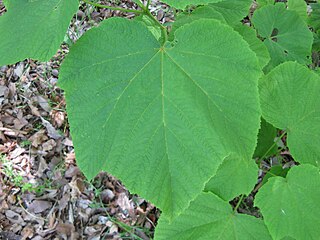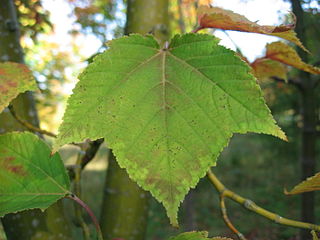Acer douglasense is an extinct maple species in the family Sapindaceae described from fossil leaves. The species is solely known from the Early Eocene sediments exposed in Katmai National Park and Preserve, Kodiak Island Borough, Alaska. It is the type species for the extinct section Douglasa.
Acer alaskense is an extinct maple species in the family Sapindaceae described from a fossil leaf. The species is solely known from the Latest Paleocene sediments exposed in the Matanuska River Valley, Matanuska-Susitna Borough, Alaska. It is the type species for the extinct section Alaskana.
Acer stonebergae is an extinct maple species in the family Sapindaceae described from two fossil samaras. The species is solely known from the Early Eocene sediments exposed in northeast Washington state, United States, and the adjacent area of south central British Columbia, Canada. It is one of three species belonging to the extinct section Torada.
Acer washingtonense is an extinct maple species in the family Sapindaceae described from one fossil leaf and four fossil samaras. The species is solely known from the Early Eocene sediments exposed in northeast Washington state, United States. It is one of three species belonging to the extinct section Torada.
Acer hillsi is an extinct maple species in the family Sapindaceae described from a single fossil samara. The species is solely known from the Early Eocene sediments exposed in northeast Washington state, United States and the adjacent area of south central British Columbia, Canada. It is one of only two species belonging to the extinct section Stewarta.
Acer stewarti is an extinct maple species in the family Sapindaceae described from a series of fossil leaves and samaras. The species is solely known from the Early Eocene sediments exposed in south central British Columbia, Canada adjacent to northeast Washington state, United States. It is one of only two species belonging to the extinct section Stewarta.
Acer rousei is an extinct maple species in the family Sapindaceae described from a series of isolated fossil samaras. The species is solely known from the Early Eocene sediments exposed in south central British Columbia, Canada adjacent to northeast Washington state in the United States. It is the type species for the extinct monotypic section Rousea.
Acer browni is an extinct maple species in the family Sapindaceae described from a series of isolated fossil leaves and samaras. The species is known from the early to middle Miocene sediments exposed in Western Oregon, Washington state, USA and Northern Graham Island, Haida Gwaii, Canada. It is one of several extinct species placed in the living section Parviflora.

Acer smileyi is an extinct maple species in the family Sapindaceae described from a series of isolated fossil leaves and samaras. The species is known from the late Oligocene to middle Miocene sediments exposed in the states of Alaska, Idaho, Nevada, and Oregon, USA. It is one of several extinct species placed in the living section Parviflora.
Acer republicense is an extinct maple species in the family Sapindaceae described from a single fossil samara. The species is solely known from the Early Eocene sediments exposed in northeast Washington state, United States. It is the only species belonging to the extinct section Republica.
Acer ashwilli is an extinct maple species in the family Sapindaceae described from a group of fossil leaves and samaras. The species is solely known from the Early Oligocene sediments exposed in central Oregon, USA. It is one of several extinct species belonging to the living section Ginnala.
Acer clarnoense is an extinct maple species in the family Sapindaceae described from a series of isolated fossil leaves and samaras. The species is known from the late Eocene sediments exposed in the state of Oregon in the US. It is one of several extinct species placed in the living section Macrantha.
Acer dettermani is an extinct maple species in the family Sapindaceae described from a series of isolated fossil leaves. The species is known from the late Eocene to early Oligocene sediments exposed in the state of Alaska, USA. It is one of several extinct species placed in the living section Macrantha.

Acer latahense is an extinct maple species in the family Sapindaceae described from series of isolated fossil leaves. The species is known from the latest early to middle Miocene sediments exposed in the states of Oregon and Washington, USA. It is one of several extinct species placed in the living section Macrantha.
Acer traini is an extinct maple species in the family Sapindaceae described from isolated fossil samaras. The species was described from Miocene-aged fossils found in Canada and the United States of America. It is one of several extinct species placed in the living section Glabra.

Rhus malloryi is an extinct species of flowering plant in the sumac family Anacardiaceae. The species is known from fossil leaves found in the early Eocene deposits of northern Washington state, United States. The species was first described from a series of isolated fossil leaves in shale. R. malloryi is one of four sumac species to be described from the Klondike Mountain Formation, and forms a hybrid complex with the other three species.
Acer taurocursum is an extinct maple species in the family Sapindaceae described from a single fossil samara found in Late Eocene lakebed sediments exposed in the state of Nevada, US. It is one of several extinct species placed in the living section Rubra.
Acer kenaicum is an extinct maple species in the family Sapindaceae described from a pair of fossil leaves and a samara. The species is known solely from the Oligocene sediments found exposed in central coastal Alaska, US. It is one of several extinct species belonging to the living section Rubra.
Rhus republicensis is an extinct species of flowering plant in the sumac family, Anacardiaceae. The species is known from fossil leaves found in the early Eocene deposits of northern Washington state in the United States. The species was first described from fossil leaves found in the Klondike Mountain Formation. R. republicensis likely hybridized with the other Klondike Mountain formation sumac species Rhus boothillensis, Rhus garwellii, and Rhus malloryi.

Tetracentron hopkinsii is an extinct species of flowering plant in the family Trochodendraceae. The species is known from fossil leaves found in the early Eocene deposits of northern Washington state, United States and south Central British Columbia. The species was first described from fossil leaves found in the Allenby Formation. T. hopkinsii are possibly the leaves belonging to the extinct trochodendraceous fruits Pentacentron sternhartae.



